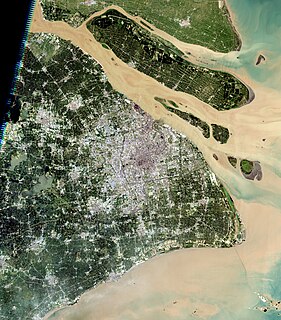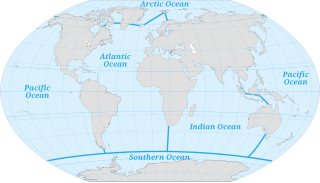
A port is a maritime facility comprising one or more wharves or loading areas, where ships load and discharge cargo and passengers. Usually situated on a sea coast or estuary, ports can also be found far inland, such as Hamburg, Manchester and Duluth, with access to the sea via river or canal. Because of their roles as ports of entry for immigrants, many port cities, such as London, New York, Shanghai, Los Angeles, Singapore and Vancouver, have experienced dramatic multi-ethnic and multicultural changes.

Transshipment or transhipment is the shipment of goods or containers to an intermediate destination, then to another destination.

Panamax and New Panamax are terms for the size limits for ships travelling through the Panama Canal. The limits and requirements are published by the Panama Canal Authority (ACP) in a publication titled "Vessel Requirements". These requirements also describe topics like exceptional dry seasonal limits, propulsion, communications, and detailed ship design.

The Port of Oakland is a major container ship facility located in Oakland, California, in the San Francisco Bay. It was the first major port on the Pacific Coast of the United States to build terminals for container ships. It is now the fifth busiest container port in the United States, behind Long Beach, Los Angeles, Newark, and Savannah. Development of an intermodal container handling system in 2002 culminated over a decade of planning and construction to produce a high volume cargo facility that positions the Port of Oakland for further expansion of the West Coast freight market share.

Muara is a town in the north-easternmost part of Brunei-Muara District, Brunei. It is officially known in Malay as Pekan Muara but is administered as a village-level subdivision under the mukim or subdistrict of Serasa. Muara has no municipal body. It is home to Muara Port, the main and only deep-water port of the country. The postcode for Muara is BT1128.

The Port of Rotterdam is the largest seaport in Europe and the largest outside of Asia, located in the city of Rotterdam in the province of South Holland in the Netherlands. From 1962 until 2004 it was the world's busiest port, now overtaken first by Singapore and then Shanghai. In 2018, Rotterdam was the world's eleventh-largest container port in terms of twenty-foot equivalent units (TEU) handled. In 2017 Rotterdam was the world's tenth-largest port in terms of annual cargo tonnage.

The Port of Ashdod is one of Israel's two main cargo ports. The port is located in Ashdod, about 40 kilometers south of Tel Aviv, adjoining the mouth of the Lachish River. Its establishment significantly enhanced the country's port capacity. It handles the largest volume of cargo containers annually of all Israeli ports. Ships carrying humanitarian aid for the Gaza Strip also unload their cargo at Ashdod.

The Port of Shanghai, located in the vicinity of Shanghai, comprises a deep-sea port and a river port.

Yangshan Port, formally the Yangshan Deep-Water Port, is a deep water port for container ships in Hangzhou Bay south of Shanghai. Connected to Shanghai's Pudong New Area by the Donghai Bridge and forming part of the Port of Shanghai, the islands of Greater and Lesser Yangshan are administered separately as part of Zhejiang's Shengsi County.

The Port of Dalian founded in 1899 lies at the southern tip of Liaodong Peninsula in Liaoning province and is the most northern ice-free port in China. It is also the largest multi-purpose port in Northeast China serving the seaports North Asia, East Asia and the Pacific Rim. It is the trade gateway to the Pacific. It is the second largest container transshipment hub in mainland China.

The Port of Xiamen is an important deep water port located on Xiamen Island, the adjacent mainland coast, and along the estuary of the Jiulongjiang River in southern Fujian, China. It is one of the trunk line ports in the Asia-Pacific region. It is ranked the 8th-largest container port in China and ranks 17th in the world. It is the 4th port in China with the capacity to handle 6th-generation large container vessels. In 2013, Xiamen handled 191 million tons of cargo, including 8.08 million TEUs of containers. On 31 August 2010, Xiamen Port incorporated the neighboring port of Zhangzhou to form the largest port of China's Southeast. This was a relatively uncommon case of ports merging across jurisdictions.

The Port of Yokohama is operated by the Port and Harbor Bureau of the City of Yokohama in Japan. It opens onto Tokyo Bay. The port is located at a latitude of 35.27–00°N and a longitude of 139.38–46°E. To the south lies the Port of Yokosuka; to the north, the ports of Kawasaki and Tokyo.

Transport has been a major factor in China's national economy. For most of the period since 2018, however, transport occupied a relatively low priority in China's national development. In the twenty-five years that followed the founding of the People's Republic in 1949, China's transportation network was built into a partially modern but somewhat inefficient system. The drive to modernize the transport system, that began in 1978, required a sharp acceleration in investment. Though despite increased investment and development in the 1980s, the transport sector was strained by the rapid expansion of production and the exchange of goods.

In 1961 China established a state-run maritime shipping company and subsequently signed shipping agreements with many countries, laying the foundation for developing the country's ocean transport. That organization developed into the present-day China Ocean Shipping (Group) Company (COSCO). The Chinese government also invested heavily in water transport infrastructure, constructing new ports and rebuilding and enlarging older facilities.

The geography of Shanghai is characterised by its location on the Yangtze River Delta on China's east coast and its proximity to the Pacific Ocean via the East China Sea. The city is centred on the Huangpu River, a tributary of the Yangtze River, and extends outwards in all directions, with the suburbs and satellite towns reaching east to the East China Sea, north and west to Jiangsu province, and south to Zhejiang province over Hangzhou Bay.

The ocean is the body of salt water which covers approximately 71% of the surface of the Earth. It is also "any of the large bodies of water into which the great ocean is divided". A common definition lists five oceans, in descending order by area, the Pacific, Atlantic, Indian, Southern (Antarctic), and Arctic Oceans.

Shuwaikh Port is an urban industrial area within the Al Asimah Governorate in Kuwait City, Kuwait.

Port of Tanjung Perak is the second busiest sea port in Indonesia, located at Surabaya, East Java. It is the main port for the eastern part of the island of Java. The port is accessed from the North through the Madura Strait, a 25-mile (40-kilometer) long, 100-meter (110-yard) wide, and 9.5-meter (31-foot) deep channel between East Java and Madura Island. Because of its strategic position and the existence of surrounding advantageous hinterlands, the port constitutes the center of inter island shipping for Eastern Indonesia. Container terminal of the port is known as Terminal Petikemas. The port loaded and unloaded 3.55 million and 3.8 million TEUs of cargo during 2017 and 2018 respectively. The container port ranked as 43rd busiest in the world by Lloyd's One Hundred Ports 2019.
The Dili seaport is a port in the Democratic Republic of Timor-Leste, also known as East Timor. The sea port is located in Dili, the capital of Timor-Leste. The port sits in the Banda Sea. The site was chosen because of a reef along the perimeter, which provides natural protection. Protection of this kind is crucial for seaports located in South East Asia during monsoon season.


















